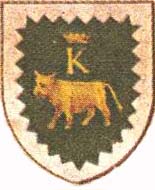
Paolo Savi was an Italian geologist and ornithologist.

The House of Bove is an ancient noble patrician family of Ravello, Maritime Republic of Amalfi that held royal appointments in the Kingdom of Naples, and presided over feudal territories. After the dissolution of noble seats of the Kingdom of Naples in 1800 they were ascribed in the Libro d'Oro of Ravello. The Bove coat of arms is prominently displayed in the Duomo of Ravello.

Giovanni Domenico Nardo was an Italian naturalist from Venice, although he spent most of his life in Chioggia, home port of the biggest fishing flotilla of the Adriatic. He learned taxidermy and specimen preparation from his uncle, an abbot. He went in a high school in Udine and studied medicine in Padua, where he reorganized the zoological collections. In 1832 he reorganized the invertebrate collection at the Imperial Natural History Museum in Vienna and in 1840 he became Fellow of the Istituto Veneto di Scienze, Lettere ed Arti, an academy whose aim is "to increase, promulgate, and safeguard the sciences, literature and the arts". Nardo wrote hundreds of scientific publications ranging from medicine and social sciences, philology, technology, physics, but mostly on Venetian and Adriatic zoology. In marine biology, Nardo wrote on algae, marine invertebrates, fishes and sea turtles. A vast collection of his manuscripts and his personal library is preserved in the Natural History Museum of Venice.

Achille Costa was an Italian zoologist working mainly in entomology who was appointed director of the Zoological Museum of Naples. He founded the entomological collections in Naples and described many new species.

Francesco (de') Ficoroni (1664–1747) was an Italian connoisseur and antiquarian in Rome closely involved with the antiquities trade. He was the author of numerous publications on ancient Roman sculpture and antiquities, guides to the monuments of Rome and the city's ancient topography, and on Italian theatre and theatrical masks, among other subjects. For his antiquarian works he was made a Fellow of the Royal Society of London. A major segment of his potential audience, both for his publications and for the objects from his perpetually changing collection, was composed of British milordi on their Grand Tours. His complementary volumes on ancient and modern Rome (1744) remained in print long after his death: Thomas Jefferson purchased both volumes while he was abroad in 1785-89.

Girolamo Tartarotti was an Italian abbot, Neo-Platonist, and writer, primarily famed for his works on witchcraft.
Alessandro Borgia was an Italian bishop and archbishop.
Maurizio Trifone is an Italian linguist and lexicographer.
Angelo Torricelli is an Italian architect.

Salvatore Trinchese was an Italian zoologist who specialised in Mollusca.

Monastero delle Murate is a former Benedictine convent on Via Ghibellina in Florence, Italy. For about a hundred years, from 1883 to 1985, it was the men's prison in Florence, after which the detainees were transferred to Sollicciano and other facilities. Since the 21st century, it has served as a restaurant and meeting places, with additional apartments, bars, restaurants and shops. The religious community dates to 1370 when 12 women became voluntarily reclusive in a shack by the second pillar of the Ponte Rubaconte, praying and living on alms in extremely difficult conditions. Given the growth in the number of sisters, in 1424, Giovanni de 'Benci, who lived nearby, financed the construction of a new, larger monastery near the walls, called the Most Holy Annunciation and St. Catherine. The monastery was renovated and expanded for the first time in 1471, following a fire, and then in 1571, after a flood. Supporters included Lorenzo de' Medici. Also in 1509 Caterina Sforza was buried in the monastery.

Antonio Mongitore was a Sicilian presbyter, historian and writer, known for his works about the history of Sicily. He was also canon of the cathedral chapter of Palermo.

Luca de Samuele Cagnazzi was an Italian archdeacon, scientist, mathematician, political economist. He also wrote a book about pedagogy and invented the tonograph.
Giuseppe Maria Giovene was an Italian archpriest, naturalist, agronomist, geologist, meteorologist, entomologist and ichthyologist. He is best known for his studies on the "nitrosity" of Pulo di Molfetta, which made him famous abroad, so as to be cited and appreciated by many Italian and foreign scholars, including Eberhard August Wilhelm von Zimmermann in a French publication.

Gustavo Frizzoni was an Italian art critic and art historian.

The Baths of the Rotonda are the remains of one of several Roman public baths in the city of Catania, Sicily. Built between the 1st and 2nd century CE, they are not far from the Roman theatre and the odeon. In the Byzantine era, the church of Santa Maria della Rotonda with its characteristic dome was built upon the remains of the Roman baths. Its walls are still covered in medieval and baroque frescoes.
Antonio Lorenzoni was an Italian lawyer, jurist and music theorist.
Francesco Ferrara was an Italian geologist, active mainly in Sicily, and known for his studies in vulcanology.

Florentia was a Roman city in the Arno valley from which Florence originated. According to tradition, it was built by the legions of Gaius Julius Caesar in 59 BC; however, the prevailing hypothesis dates the foundation of the city to the Augustan period.














